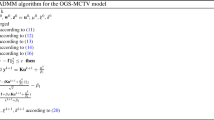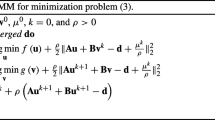Abstract
Total variation is a very popular method for image restoration, yet it produces undesirable staircase artifacts. In this paper, a combined second-order non-convex total variation with overlapping group sparse regularizer for staircase artifact removal is proposed. The non-convex higher-order TV regularizer is introduced to model the observation that the staircase effect must be appropriately smoothen out in the restored image while preserving its edges. However, using the non-convex higher-order TV alone tends to smoothen the image while amplifying speckle artifacts. To deal with this, the overlapping group sparse regularizer is added to balance the effects produced by the non-convex higher-order TV regularizer. An efficient re-weighted \(\ell _1\) alternating direction method is formulated to solve the corresponding iterative scheme. Comparative analysis with three algorithms, namely overlapping group sparse total variation, total generalized variation and the fast non-smooth non-convex method, with two different blur kernels is carried out. The results from peak signal-to-noise ratio and structural similarity index measure show the effectiveness of our proposed method when compared to the mentioned algorithms.




Similar content being viewed by others
Notes
The Cell image obtained from: http://www.cellimagelibrary.org.
The Brain and Liver images obtained from: http://adni.loni.usc.edu.
Additional images for visual inspection are provided in “Appendix” as a supplementary file.
References
Avcibas, I., Sankur, B., Sayood, K.: Statistical evaluation of image quality measures. J. Electron. Imaging 11(2), 206–224 (2002)
Boyd, S., Parikh, N., Chu, E., Peleato, B., Eckstein, J.: Distributed optimization and statistical learning via the alternating direction method of multipliers. Found. Trends® Mach. Learn. 3(1), 1–122 (2011)
Bredies, K., Kunisch, K., Pock, T.: Total generalized variation. SIAM J. Imag. Sci. 3(3), 492–526 (2010). https://doi.org/10.1137/090769521
Candes, E.J., Wakin, M.B., Boyd, S.P.: Enhancing sparsity by reweighted \(\ell 1\) minimization. J. Fourier Anal. Appl. 14(5–6), 877–905 (2008)
Chan, S.H., Khoshabeh, R., Gibson, K.B., Gill, P.E., Nguyen, T.Q.: An augmented lagrangian method for total variation video restoration. IEEE Trans. Image Process. 20(11), 3097–3111 (2011)
Chen, C., Peng, Z., Huang, J.: O (1) algorithms for overlapping group sparsity. In: 22nd International conference on pattern recognition (ICPR), 2014, pp. 1645–1650. IEEE (2014)
Chen, G.H., Yang, C.L., Po, L.M., Xie, S.L.: Edge-based structural similarity for image quality assessment. In: IEEE International Conference on Acoustics, Speech and Signal Processing, ICASSP Proceedings, vol. 2, pp. II–II. IEEE (2006)
Chen, P.Y., Selesnick, I.W.: Translation-invariant shrinkage/thresholding of group sparse signals. Signal Process 94, 476–489 (2014)
Du, H., Liu, Y.: Minmax-concave total variation denoising. Signal, Image and Video Processing, pp. 1–8 (2018)
Guo, W., Qin, J., Yin, W.: A new detail-preserving regularization scheme. SIAM J. Imaging Sci. 7(2), 1309–1334 (2014)
He, C., Hu, C., Yang, X., He, H., Zhang, Q.: An adaptive total generalized variation model with augmented lagrangian method for image denoising. Math. Problems Eng. 2014, 11 (2014)
Hore, A., Ziou, D.: Image quality metrics: PSNR vs. SSIM. In: 20th International Conference on Pattern recognition (ICPR), pp. 2366–2369. IEEE (2010)
Liu, J., Huang, T.Z., Selesnick, I.W., Lv, X.G., Chen, P.Y.: Image restoration using total variation with overlapping group sparsity. Inf. Sci. 295, 232–246 (2015)
Lysaker, M., Lundervold, A., Tai, X.C.: Noise removal using fourth-order partial differential equation with applications to medical magnetic resonance images in space and time. IEEE Trans. Image Process. 12(12), 1579–1590 (2003)
Nikolova, M., Ng, M.K., Tam, C.P.: Fast nonconvex nonsmooth minimization methods for image restoration and reconstruction. IEEE Trans. Image Process. 19(12), 3073–3088 (2010)
Papafitsoros, K., Schönlieb, C.B.: A combined first and second order variational approach for image reconstruction. J. Math. Imaging Vis. 48(2), 308–338 (2014)
Rudin, L.I., Osher, S., Fatemi, E.: Nonlinear total variation based noise removal algorithms. Physica D: Nonlinear Phenomena 60(1), 259–268 (1992)
Selesnick, I.W., Chen, P.Y.: Total variation denoising with overlapping group sparsity. In: IEEE International conference on acoustics, speech and signal processing (ICASSP), pp. 5696–5700. IEEE (2013)
Shi, M., Han, T., Liu, S.: Total variation image restoration using hyper-Laplacian prior with overlapping group sparsity. Signal Processing 126, 65–76 (2016)
Wang, Y., Yang, J., Yin, W., Zhang, Y.: A new alternating minimization algorithm for total variation image reconstruction. SIAM J. Imag. Sci. 1(3), 248–272 (2008)
Wang, Z., Bovik, A.C., Sheikh, H.R., Simoncelli, E.P.: Image quality assessment: from error visibility to structural similarity. IEEE Trans. Image Process. 13(4), 600–612 (2004)
Wu, C., Tai, X.C.: Augmented lagrangian method, dual methods, and split Bregman iteration for rof, vectorial tv, and high order models. SIAM J. Imaging Sci. 3(3), 300–339 (2010). https://doi.org/10.1137/090767558
Xu, J., Feng, X., Hao, Y., Han, Y.: Image decomposition using adaptive second-order total generalized variation. Signal Image Video Process. 8(1), 39–47 (2014)
Xu, J., Hao, Y., Li, M., Zhang, X.: A novel variational model for image decomposition. In: Signal, Image and Video Processingpp, pp. 1–8 (2019)
You, Y.L., Kaveh, M.: Fourth-order partial differential equations for noise removal. IEEE Trans. Image Process. 9(10), 1723–1730 (2000)
Author information
Authors and Affiliations
Corresponding author
Additional information
Publisher's Note
Springer Nature remains neutral with regard to jurisdictional claims in published maps and institutional affiliations.
Electronic supplementary material
Below is the link to the electronic supplementary material.
Rights and permissions
About this article
Cite this article
Adam, T., Paramesran, R. Hybrid non-convex second-order total variation with applications to non-blind image deblurring. SIViP 14, 115–123 (2020). https://doi.org/10.1007/s11760-019-01531-3
Received:
Revised:
Accepted:
Published:
Issue Date:
DOI: https://doi.org/10.1007/s11760-019-01531-3




